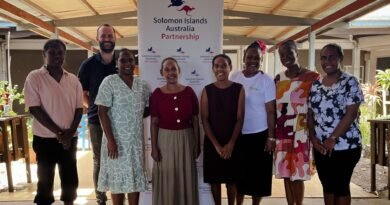New Tourism Model Introduced in SI
BY LYNNISSHA RUNA
LOCAL Tourism operators in Solomon Islands have now been given the opportunity to benefit from a new tourism destination management model called the St Gallen Model.
This new and innovative model aims to link tourism attraction sites and facilitates travellers’ flow through a destination. It has been applied in tourism development projects in Europe, Asia and Africa, and island environments such as Cyprus and Lanzarote.
There were respective workshops initially held in Honiara, Guadalcanal and Gizo, Western Province over the recent weeks to introduce the St Gallen Model for Destination Management into the country.
Ministry of Culture and Tourism Under Secretary Moses Tepai said, “The St Gallen Model is a platform for significant economic opportunities and benefits for the industry. The findings and actions will inform our National Development Strategy for Tourism, particularly in Western Province.”
“This approach is ideal for packaging our unique natural and cultural based attractions, including those in Marovo Lagoon, Munda and Gizo. Adventure attractions such as diving, surfing, fishing, nature and World War II sites, all have incredible tourism appeal and potential to attract investors,” he told participants at the workshop.
He said the Government’s main ambition is to improve the economic growth in the tourism sector throughout the Solomon Islands.
“For now we are looking at this two best tourism hubs in the country, which is in the Western province and Honiara. We will comprehend and if it can supplement the work of the government then later on we can look at plans on how we can introduce it other provinces as well.
“The main ambition is to improve economic growth in the tourism sector throughout the Solomon Islands,” Ministry of Culture and Tourism Under Secretary Moses Tepai added.
The workshops are primarily supported by the Australian Government initiative Strongim Bisnis and also part of the Australian Government’s broader tourism support, under a partnership with the Western Province Tourism Association.
Meanwhile, the Workshop Facilitator And Hotel And Tourism Industries Expert, David Ermen described how to use maps and visualise tourists movements, can essentially help local tourism operators in the country to better understand the tourism demand and profile.
“The Solomon Islands are geographically spread out and tourism happens in many different areas for different activities. Using the St Gallen Model will assist in developing sustainable tourism from the beginning, without jeopardising the social and ecological environment,” Ermen said.
From an academic stance, the St Gallen Destination Management Model (SGDM) focus on strategic visitor flows serves as the foundation of a new paradigm in destination management and points to avenues for further research.
“The St. Gallen Model for Destination Management (SGDM) introduces an alternative perspective that allows transcending past boundaries and thus getting closer to the real complexities of managing tourist behaviour in dynamic systems. While this may sound daunting, it starts with something very practical: The observation of how tourists of different kinds move about as flows of visitors. Strategic visitor flows (SVF) are the basic unit of analysis and planning of the new model.
“The model connects these flows to demand and supply networks. Underlying mechanisms explain the social forces that drive tourists’ behavior and the interdependencies that determine a viable supply of tourist services in destinations. The model builds on practical experience in more than 30 destinations and the latest insights from ongoing research on destination management and marketing.
“Internationally, we observed that a basic understanding of the presence of multiple visitor flows and of the related network mechanism enabled actors (e.g., from hotels, food and lodging, operators of attractions, transportation, tourist organizations, and politicians) to break free of existing preconceptions. The model and its instruments enabled them to rethink tasks, responsibilities, and projects. This ultimately allowed them to make more efficient and effective use of their scarce resources, benefiting both visitors and destination actors.



